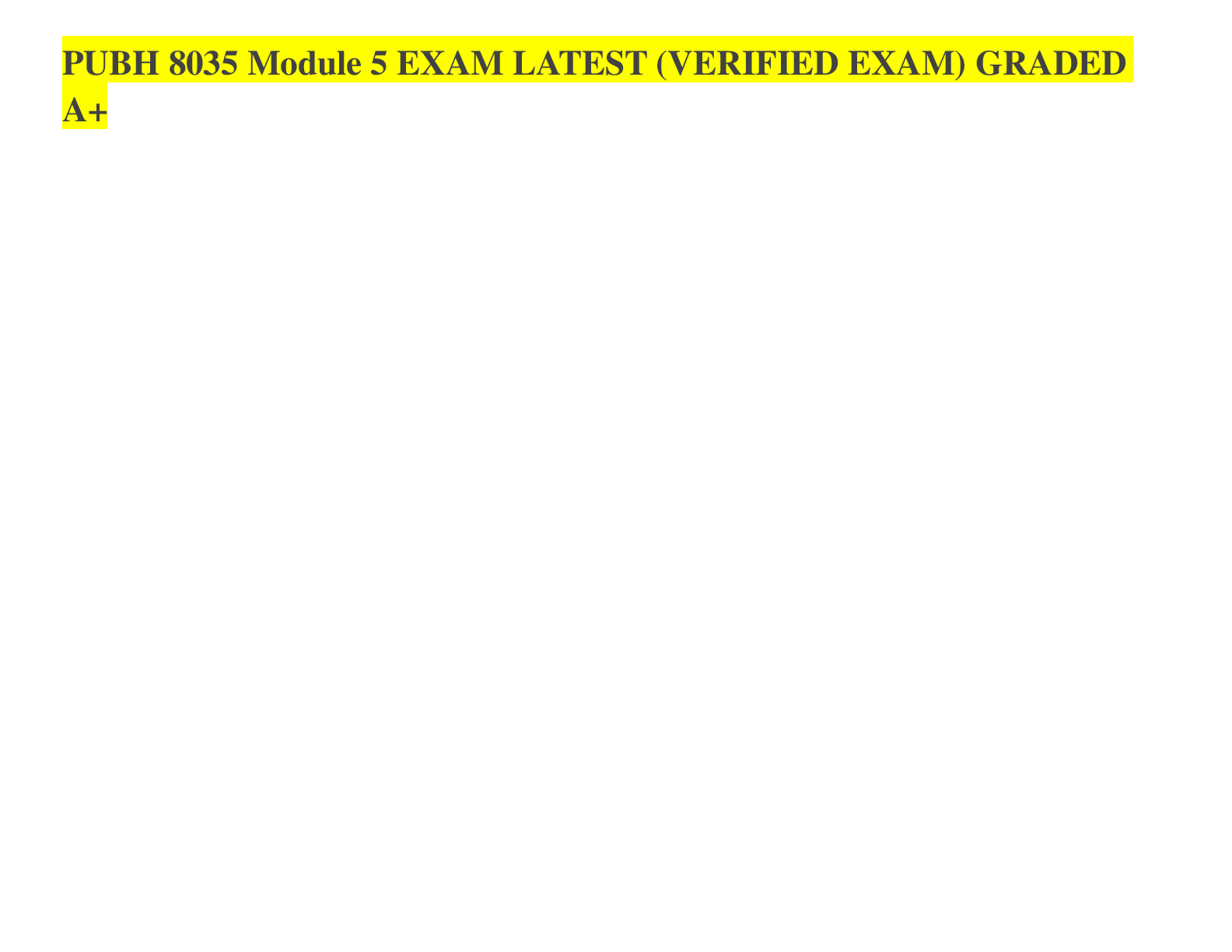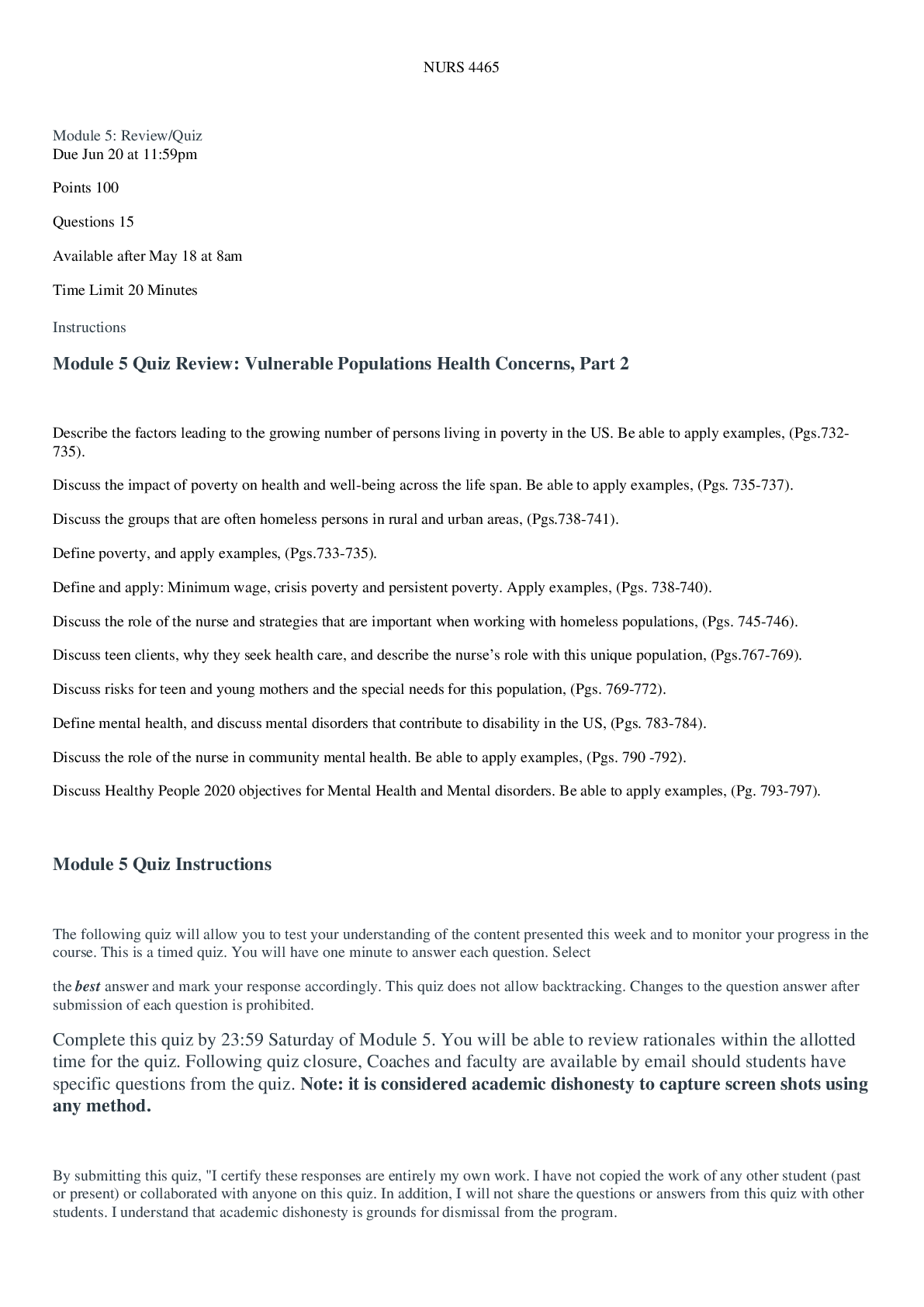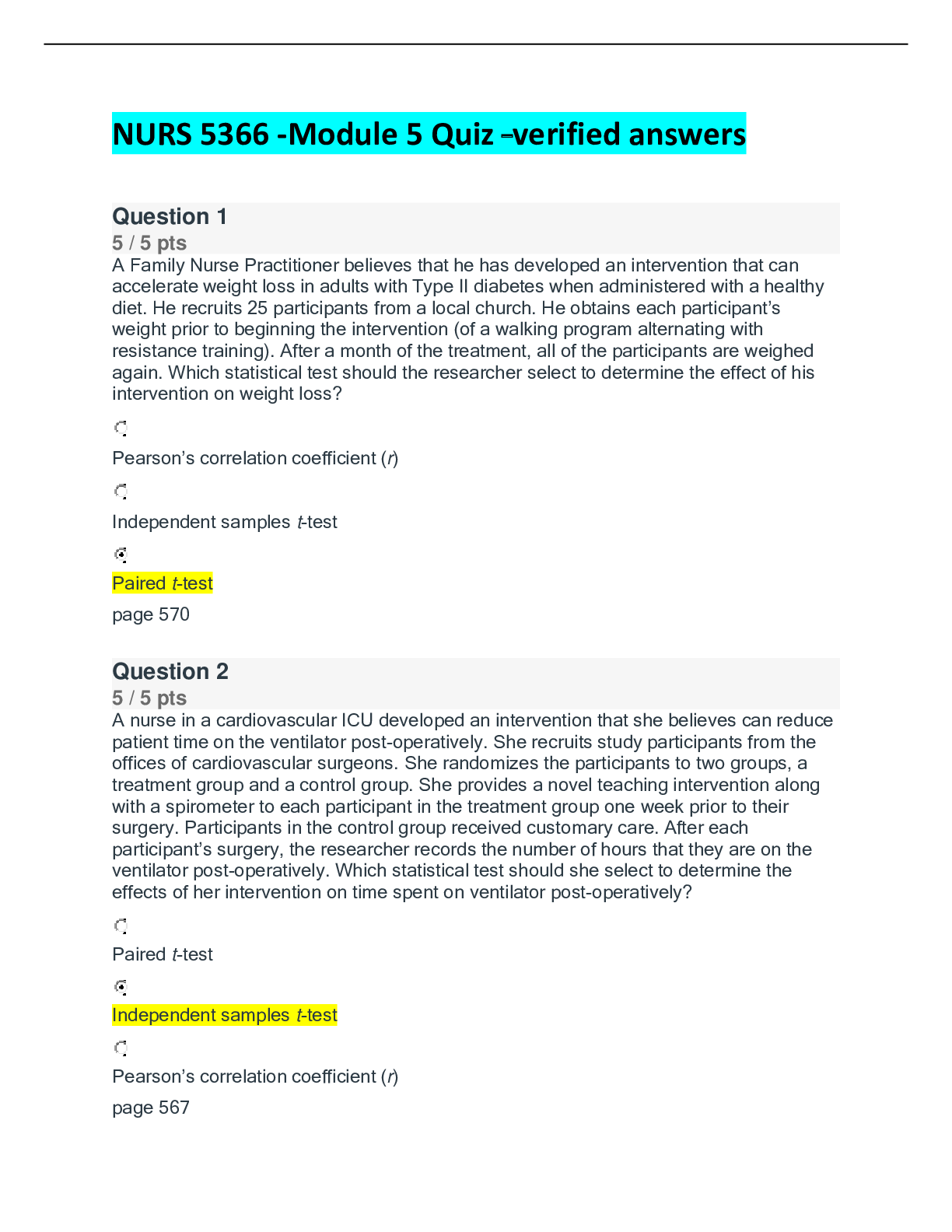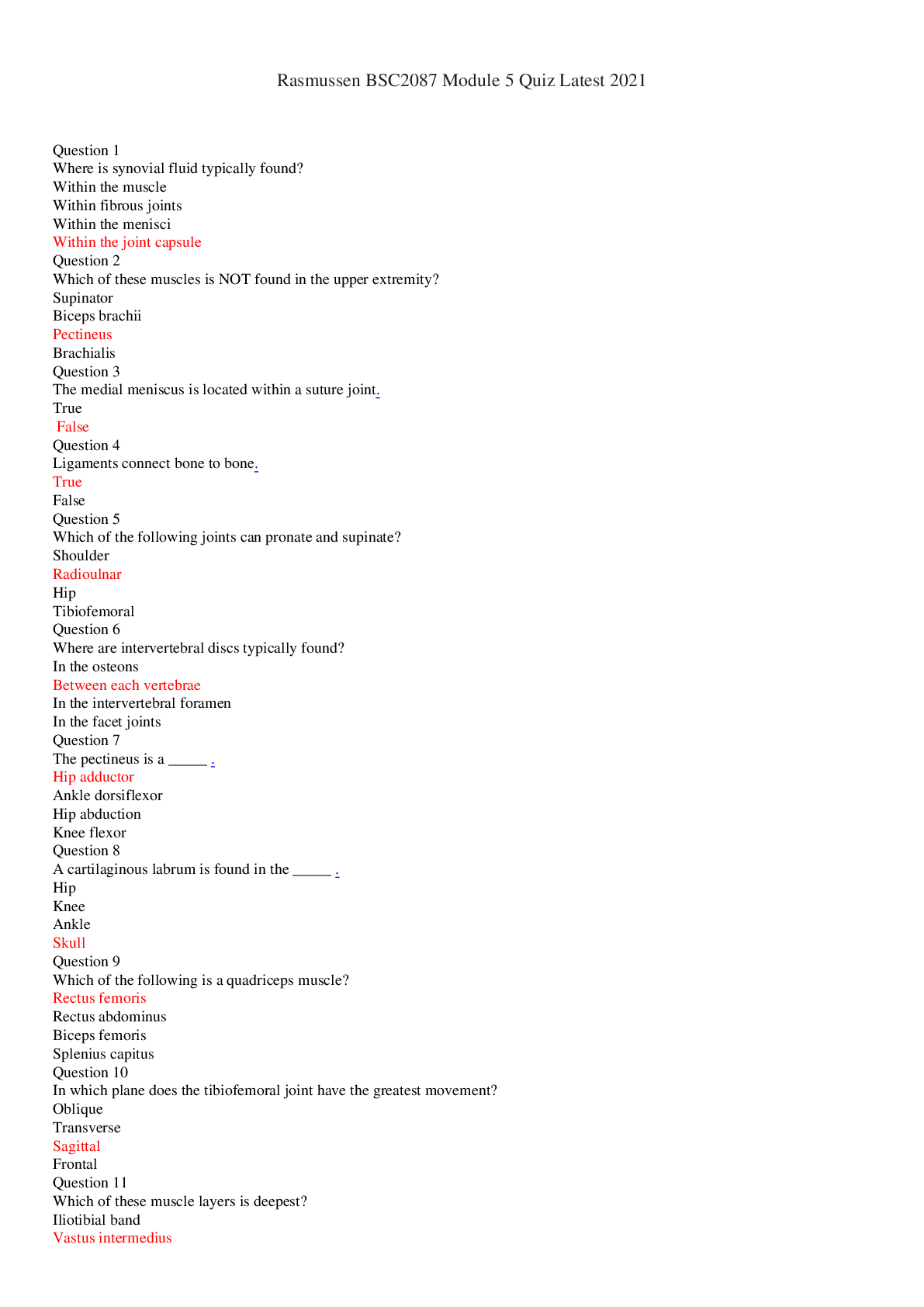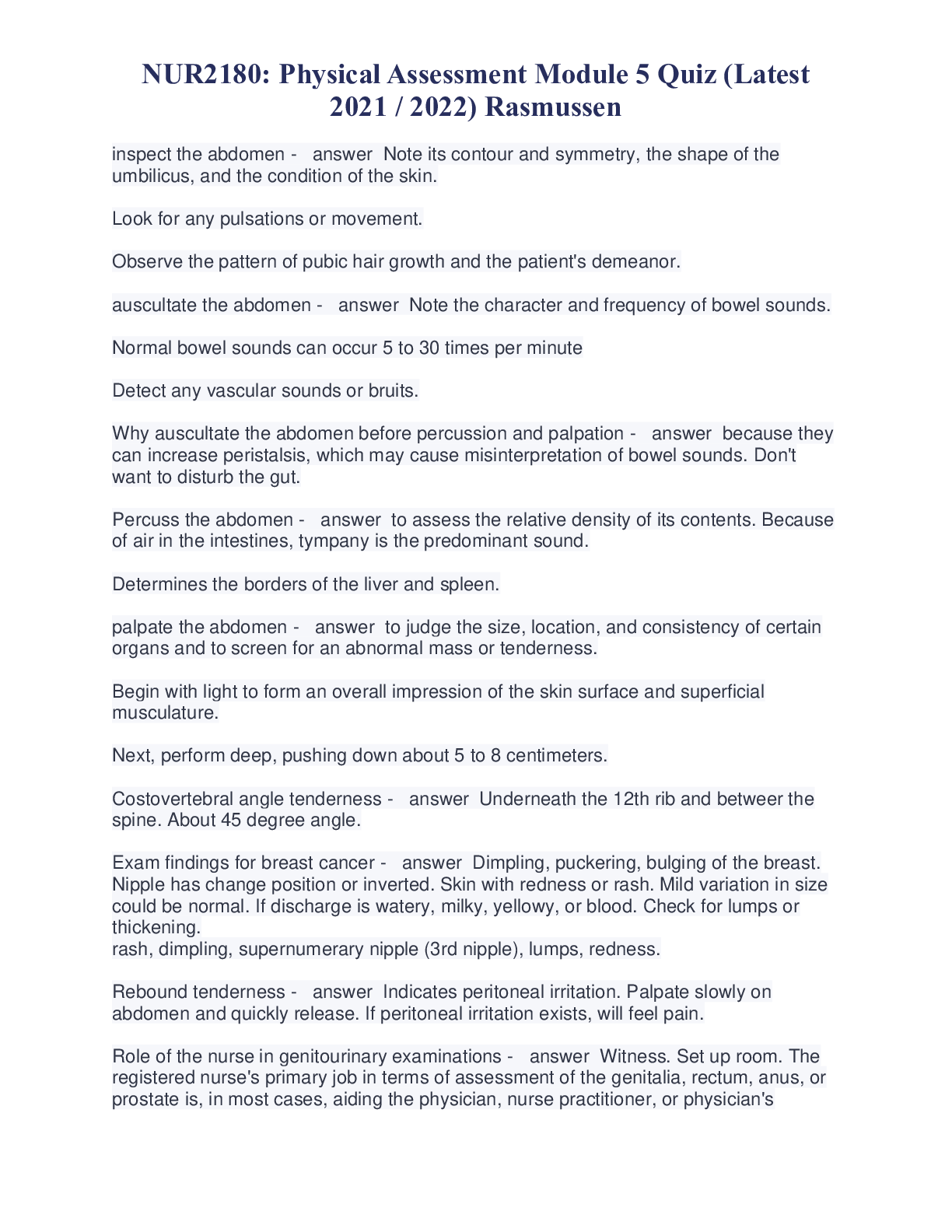BioChemistry > EXAM > C785 Biochemistry Module 5 Quiz 2020 – Western Governors University | C 785 Biochemistry Module 5 (All)
C785 Biochemistry Module 5 Quiz 2020 – Western Governors University | C 785 Biochemistry Module 5 Quiz 2020
Document Content and Description Below
C785 Biochemistry Module 5 Quiz 2020 – Western Governors University Which of the following vitamins does not travel through the bloodstream in the form of a lipid micelle? Select one: a. Vitami... n C ! Vitamin C is a water soluble vitamin that is not solubilized in lipid micelles. b. Vitamin A c. Vitamin D d. Vitamin K Which lipid has a 4-ring structure? Select one: a. Sterol ! Sterols are lipids that contain four hydrocarbon rings. Cholesterol, cortisol, and testosterone are examples of sterols. b. Fatty Acid c. Phospholipid d. Plasminogen Which of the following situations is MOST likely to increase the rate of beta oxidation? Select one: a. No fat diet b. Fasting ! Beta-oxidation is a major source of cellular energy, especially during a fast when carbohydrates are not available. Glucagon is released after fasting and promotes beta-oxidation. c. Large pasta meal prior to running a marathon d. Excess intake of Vitamin B7 (biotin) A patient who is on a no-fat diet is at particular risk of deficiency in: Select one: a. Insulin b. Iron c. Vitamin A ! Dietary fat enables the formation of lipid micelles, structures that aid in the absorption of fat-soluble vitamins like Vitamin A. d. Glucose During starvation, triglycerides can help supply some of the body’s glucose needs. Which breakdown product of triglycerides can be used to make glucose? Select one: a. Acetyl CoA In. The glycerol component of triglycerides is used to make pyruvate, while the fatty acids are used to make acetyl CoA. Gluconeogenesis (the process of making new glucose), uses pyruvate, not acetyl CoA, to make glucose. b. glycerol c. fatty acids d. diglyceride Which is likely to be liquid at the lowest temperature? Select one: a. CH3(CH2)6CH=CH(CH2)2COOH b. CH3(CH2)16COOH c. CH3(CH2)4CH=CH(CH2)8COOH In. This fatty acid is a monounsaturated fatty acid. Monounsaturated fatty acids have one double bond in the hydrocarbon tail. Double bonds create bends fatty acid molecules, making it more difficult for adjacent fatty acids to pack together tightly. The loose packing of polyunsaturated fatty acid makes them liquid at lower temperatures than saturated or monounsaturated fatty acids. d. CH3(CH2)3CH=CH(CH2)2CH=CH(CH2)3COOH Which of the following accurately describes the steps involved in fatty acid synthesis? Select one: a. Triglycerides are broken into glycerol and acetyl-CoA --> acetyl-CoA enters mitochondria --> Acetyl-CoA enters the CAC ---> The products of the CAC move on the ETC to generate fatty acids. b. Acetyl-CoA is transported to the cytoplasm ---> Biotin transfers a carboxylate group to acetyl-CoA --> The malonyl group is transferred to a carrier protein --> malonyl ACP combines with acetyl-CoA, --> malonyl-CoA is added repeatedly to the growing fatty acid c. Acetyl-CoA is transported to the mitochondrial ---> Biotin transfers a carboxylate group to acetyl-CoA --> The malonyl group is transferred to a carrier protein --> malonyl ACP combines with acetyl-CoA, --> malonyl-CoA is added repeatedly to the growing fatty acid. In. Fatty acid synthesis occurs in the cytoplasm, not the mitochondria. d. Lactic acid moves into the liver --> The liver uses ATP to generate pyruvate ---> 2 pyruvates combine to form a new fatty acid Which of the following fatty fatty acids will produce 8 Acetyl CoA molecules after it is completely metabolized via beta oxidation? Select one: a. CH3(CH2)5CH=CH(CH2)4COOH b. CH3(CH2)6CH=CH(CH2)2COOH c. CH3(CH2)6COOH d. CH3(CH2)4CH=CH(CH2)8COOH ! This fatty acid contains 16 carbons. Each acetyl CoA has two carbons. Thus, a fatty with 16 carbons will yield 8 acetyl CoA molecules. (16 divided by 2 is 8.) Which set of molecules are produced by the beta oxidation of fatty acids? Select one: a. Acetoacetyl CoA and HMG CoA In. Acetoacetyl CoA and HMG CoA are intermediates in ketogenesis. Beta oxidation breaks fatty acid molecules into two-carbon acetyl CoA molecules. As the fatty acid is oxidized, the electrons removed from the fatty acid are used to create NADH from NAD+ and FADH2 from FAD. b. Acetyl CoA, NADH, FADH2 c. Acetyl CoA, NADPH, malonyl CoA d. CO2, H2O, and ATP Gastric bypass surgery results in an increase in the production of GLP-1, a peptide that promotes insulin secretion. This is thought to be associated with the tendency for these patients' type II diabetes to resolve after the surgery. If a gastric bypass patient has a mutation in GLP-1 that impairs its function, which of the following would you expect? Select one: a. This patient would have reduced insulin secretion compared to patients with normal GLP-1, and this reduction increases fatty acid synthesis. b. This patient would have increased insulin secretion compared to patients with normal GLP-1, and this increase leads to fatty acid synthesis. In. Since GLP-1 normally increases insulin secretion, the defective GLP-1 results in reduced insulin secretion. This low insulin level would decrease fatty acid synthesis. c. This patient's diabetes would be even more likely to resolve than a patient with normal GLP-1. d. This patient would have reduced insulin secretion compared to patients with normal GLP-1, and this reduction results in increased fatty acid oxidation. Through mandatory state testing, a 2-day-old newborn is found to have medium chain acyl-CoA dehydrogenase deficiency (MCADD). This enzyme deficiency interferes with the baby’s ability to break down medium chain fatty acids via beta oxidation. Her parents need to be given specific instructions on what the baby can ingest. Which of the following is about this baby: Select one: a. She will not be able to utilize adipose tissue for ATP production as effectively as a baby without the disorder. ! Adipose tissue contains triglycerides, molecules made up of glycerol and fatty acids, including the medium chain fatty acids that the baby is unable to metabolize. Thus, the baby will not be able to use these adipose stores as effectively as a normal baby to generate ATP. b. She will have less ability to store and utilize glycogen than a baby without the disease. c. All of her calories must come entirely from protein. d. She should never be given complex carbohydrates in her diet. Which of the following contributes to the development of ketoacidosis in a diabetic patient? Select one: a. A reduction in citric acid cycle intermediates, which decreases the amount of oxaloacetate that acetyl-CoA can combine with to enter the citric acid cycle. b. An increase in citric acid cycle intermediates, which increases the amount of oxaloacetate that acetyl-CoA can combine with to enter the citric acid cycle. In. Because diabetic patients use citric acid cycle intermediates to help generate glucose via gluconeogenesis, there is expected to be a decrease in citric acid cycle intermediates. c. Low rates of fatty acid oxidation. d. The increased production of citrate from acetyl-CoA. Which of the formulae below describes a saturated fatty acid? Select one: a. C12H22O11 b. C16H32O2 c. C6H6OH In. This formula contains too few oxygen atoms, as there are two oxygens in the carboxyl group. d. C12H22O2 Unsaturated fatty acids can have different arrangements of hydrogen atoms at the double bond depending on whether the bonds are cis- or trans-configuration. A consequence of this is that_________________. Select one: a. fatty acids with trans-configuration double bonds do not pack together well which lowers their melting point. In. Fatty acids with a trans-configuration at a double bond have a shape similar to saturated fatty acids - a straight carbon chain. For this reason they are able to pack closely together which increases their melting point. b. fatty acids with cis-configuration double bonds do not pack together well which lowers their melting point. c. fatty acids with both types of configurations have shapes similar to saturated fatty acids. d. fatty acids with cis-configuration double bonds do not pack together well which increases their melting point. Which best describes fatty acid hydrogenation? Select one: a. Monounsaturated fatty acids are the only fatty acids that can be hydrogenated. b. Hydrogenation of fatty acids produces only the trans-configuration at the double bond. In. While trans fatty acids can be produced by hydrogenation, saturated fatty acids can also be produced. c. Saturated fatty acids have hydrogen added to them to increase their melting point. d. Hydrogenation converts some unsaturated fatty acids into saturated fatty acids. Phospholipids have parts that are hydrophobic (non-polar, not soluble in water) and a part that is hydrophilic (polar; water-soluble)? What term do we use to describe a molecule that is both polar and non-polar? Select one: a. Ambidextrous b. Ambitious c. Ambivalent In. This term refers to someone who has contradictory feelings. d. Amphipathic Which compounds make up the greatest reserves of energy in our bodies? Select one: a. Glucose b. Glycogen In. Glycogen is one way to store excess glucose for energy, but these are not compact and are not used for primary energy storage. c. Triglycerides d. ATP [Show More]
Last updated: 1 year ago
Preview 1 out of 7 pages
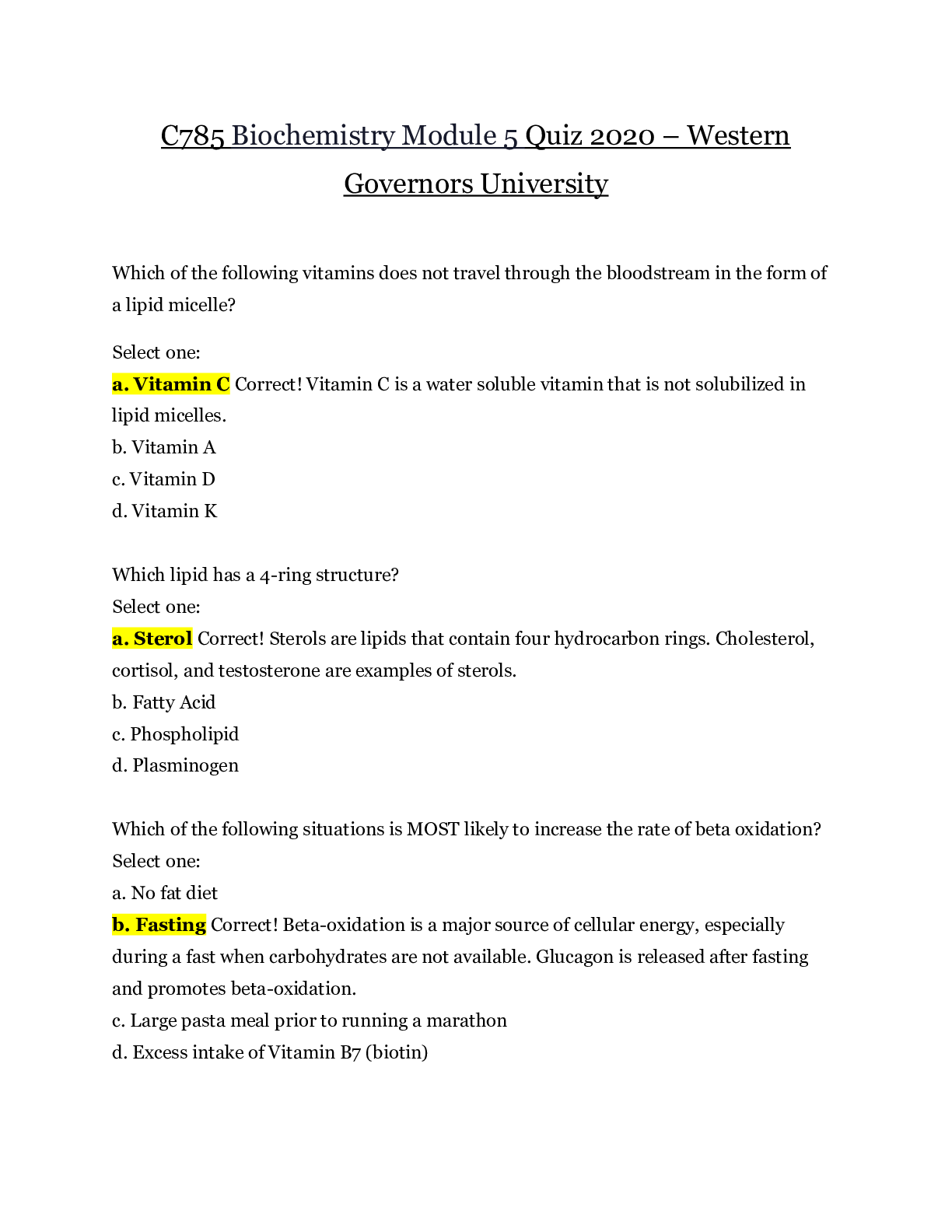
Reviews( 0 )
Document information
Connected school, study & course
About the document
Uploaded On
Nov 23, 2020
Number of pages
7
Written in
Additional information
This document has been written for:
Uploaded
Nov 23, 2020
Downloads
0
Views
35














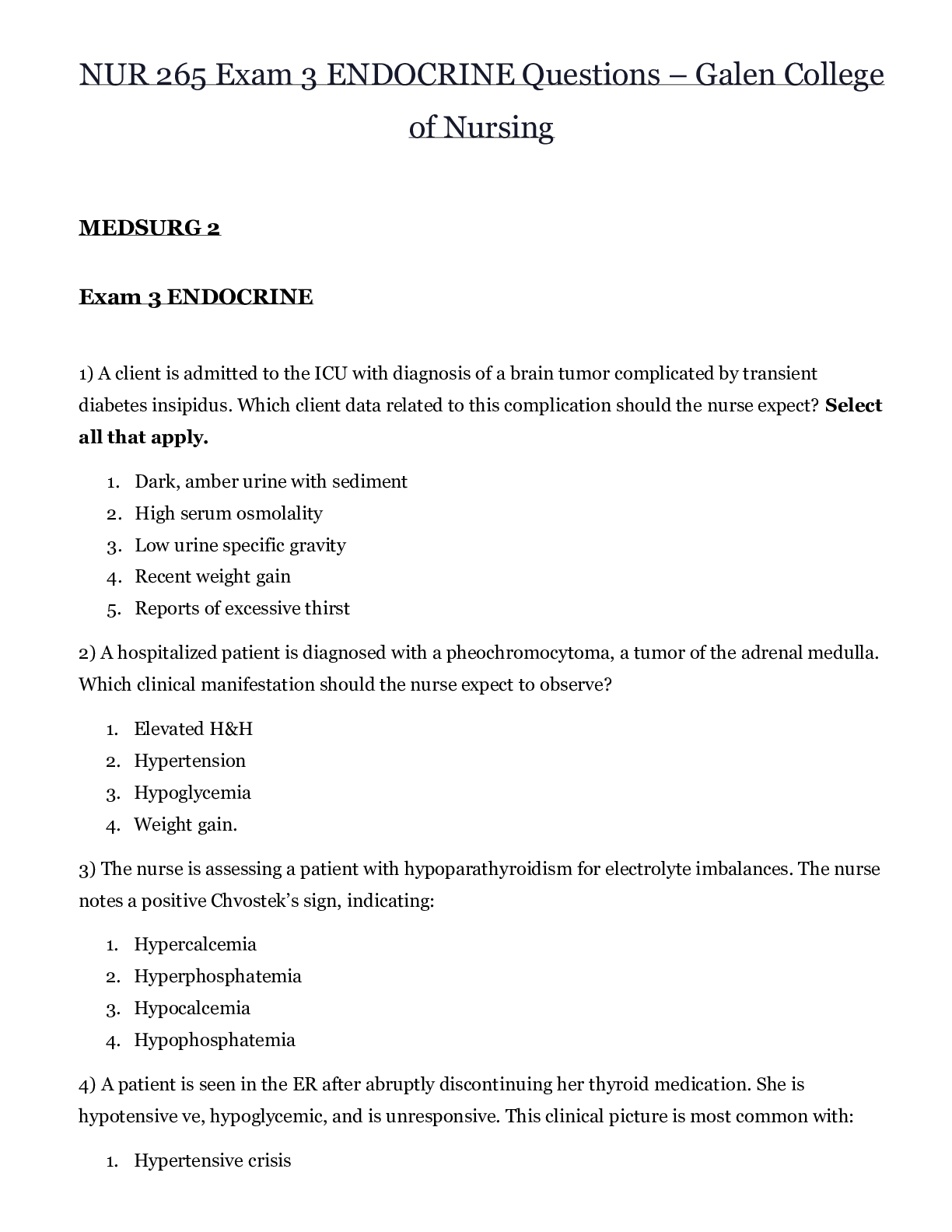
 – CHAMBERLAIN COLLEGE OF NURSING.png)
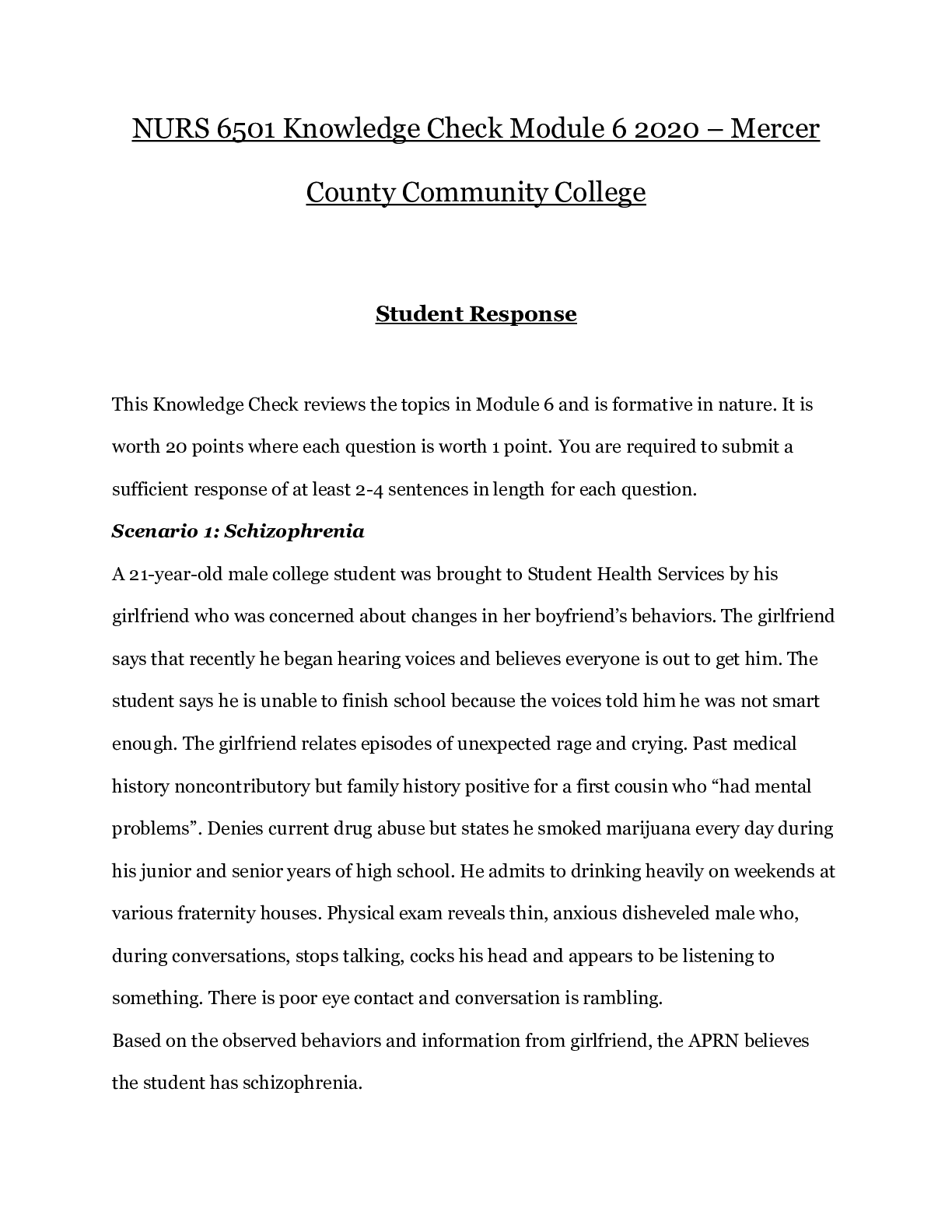
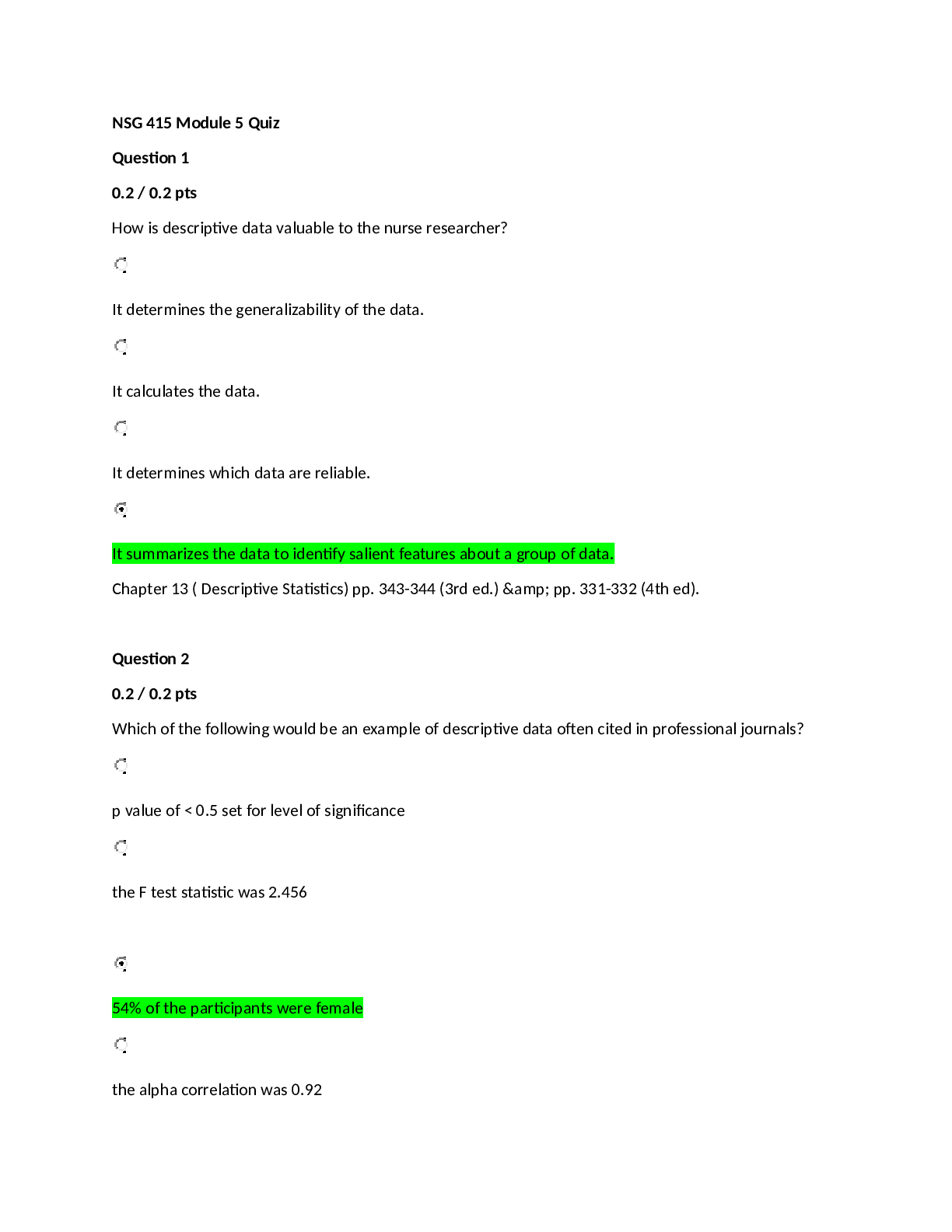
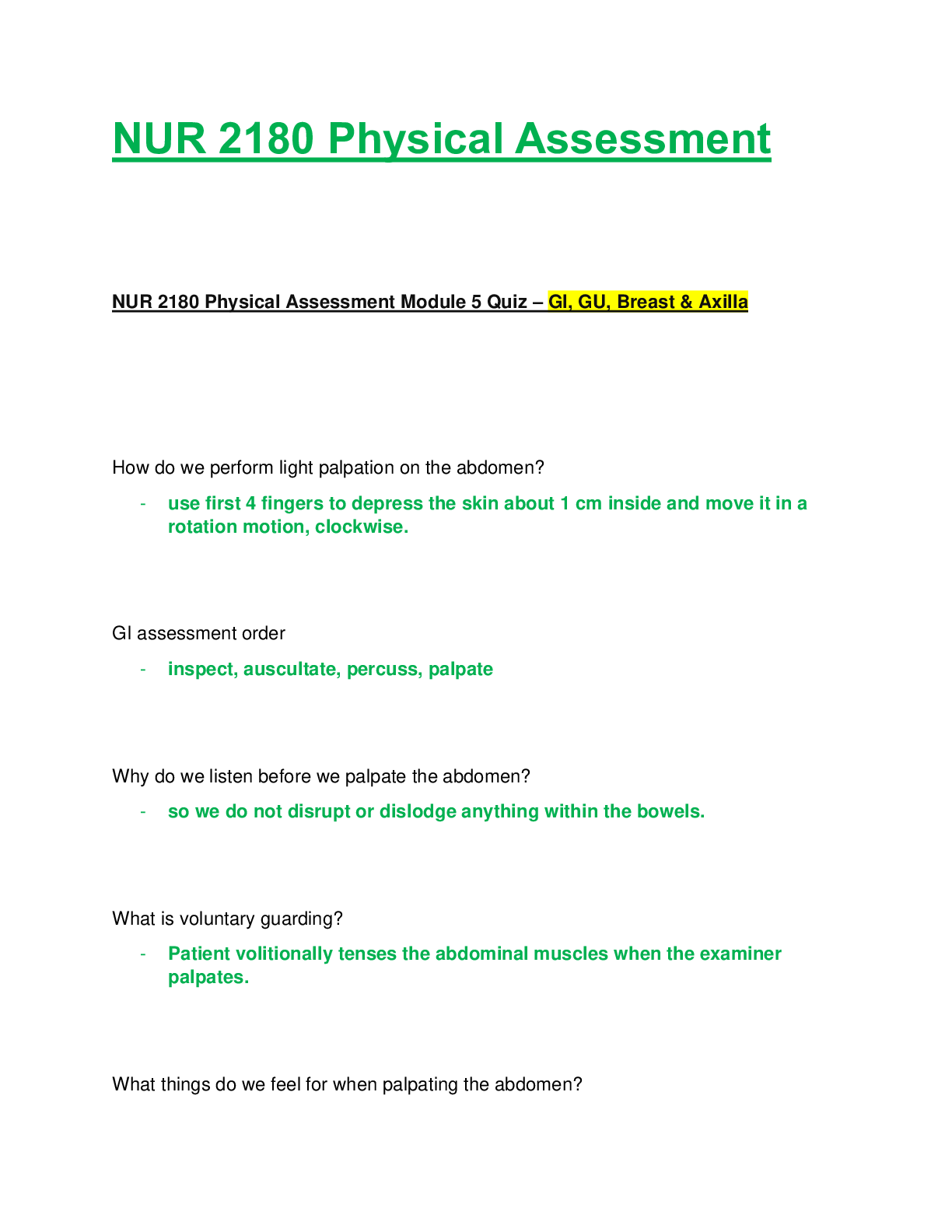
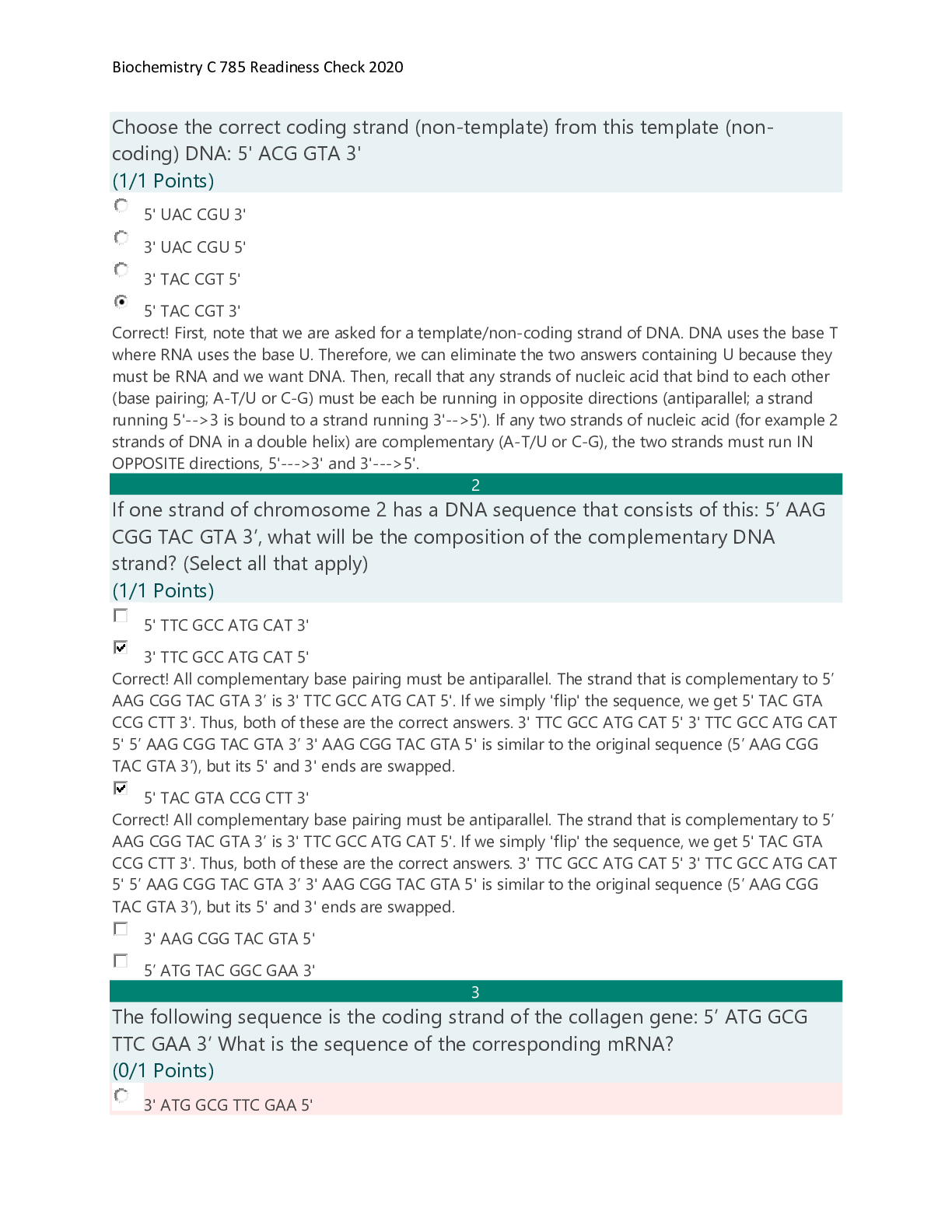
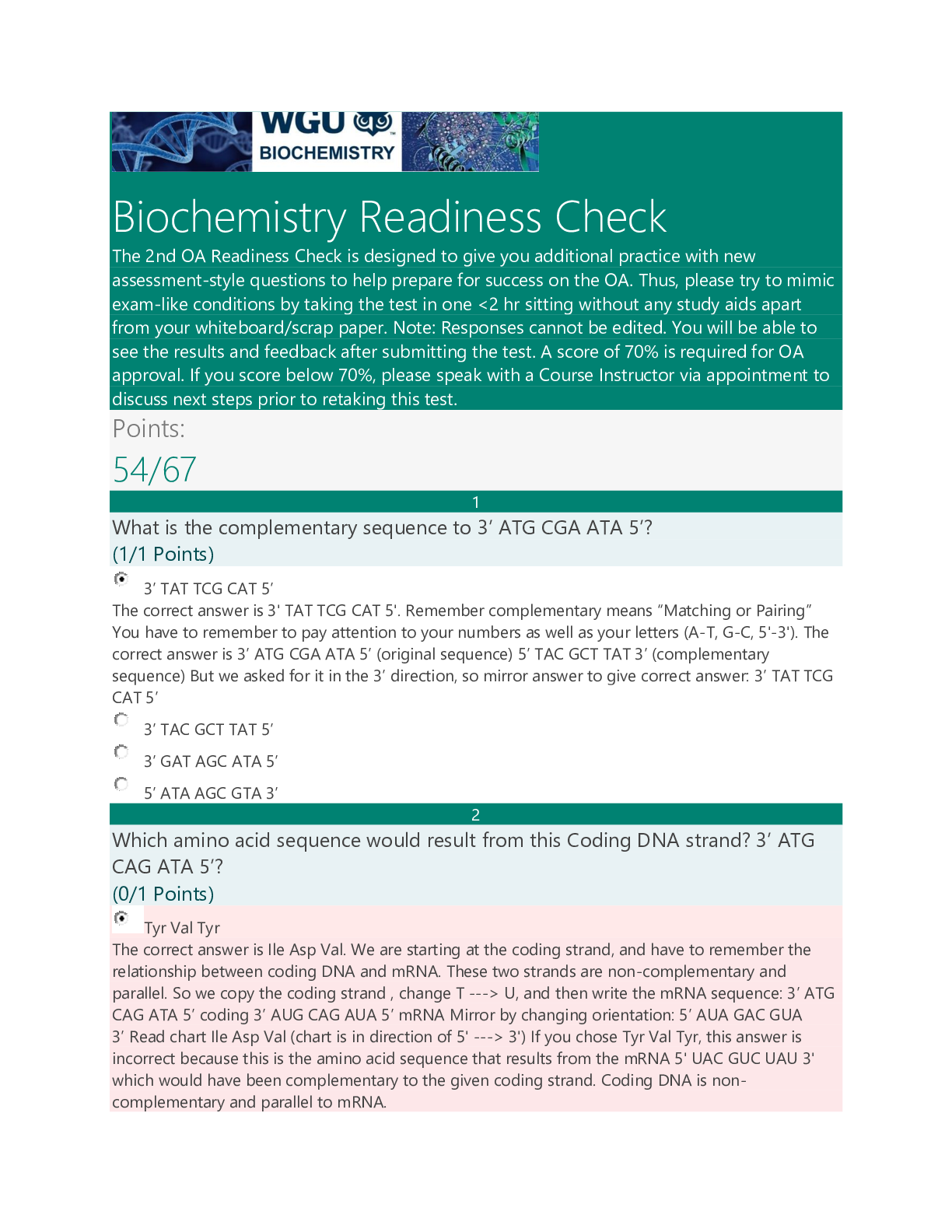
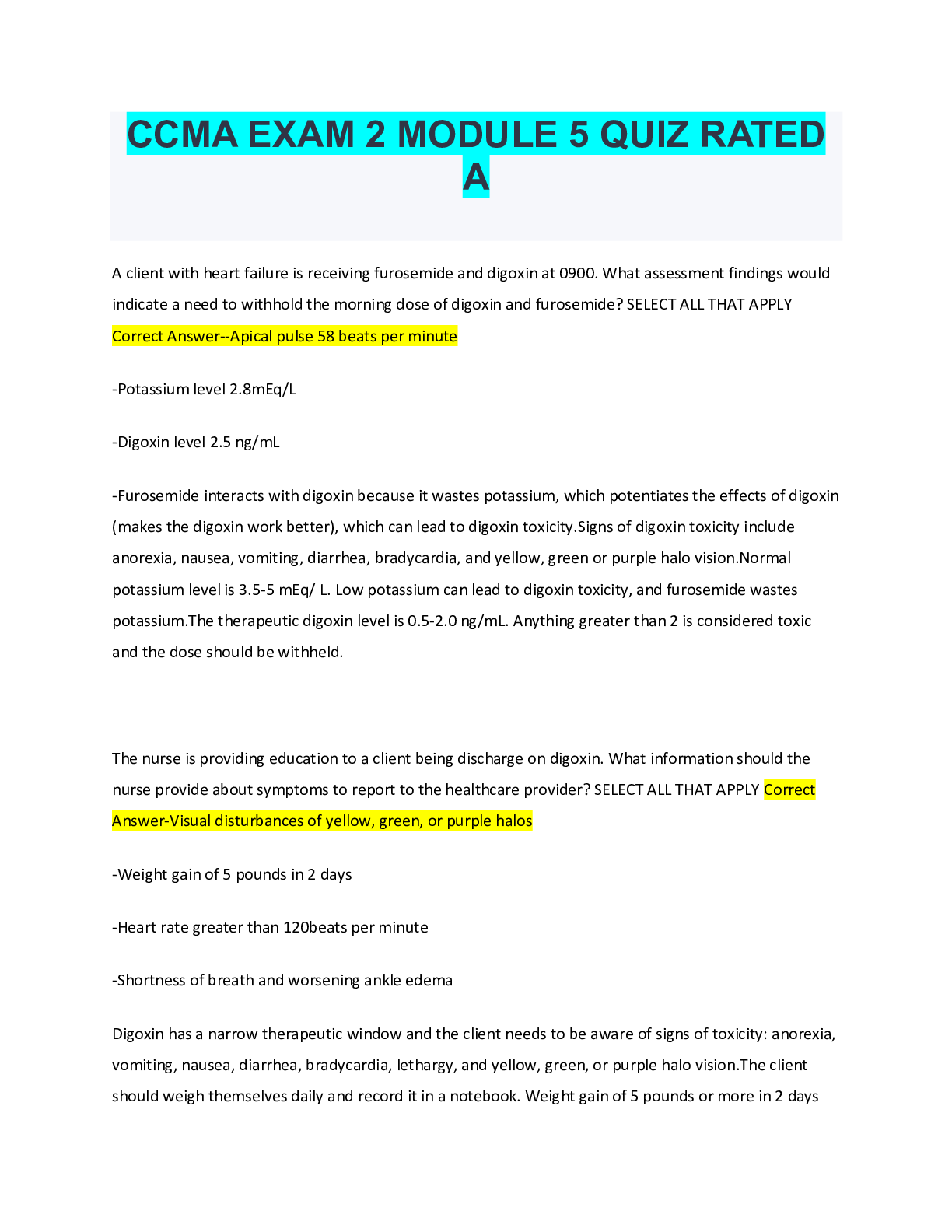
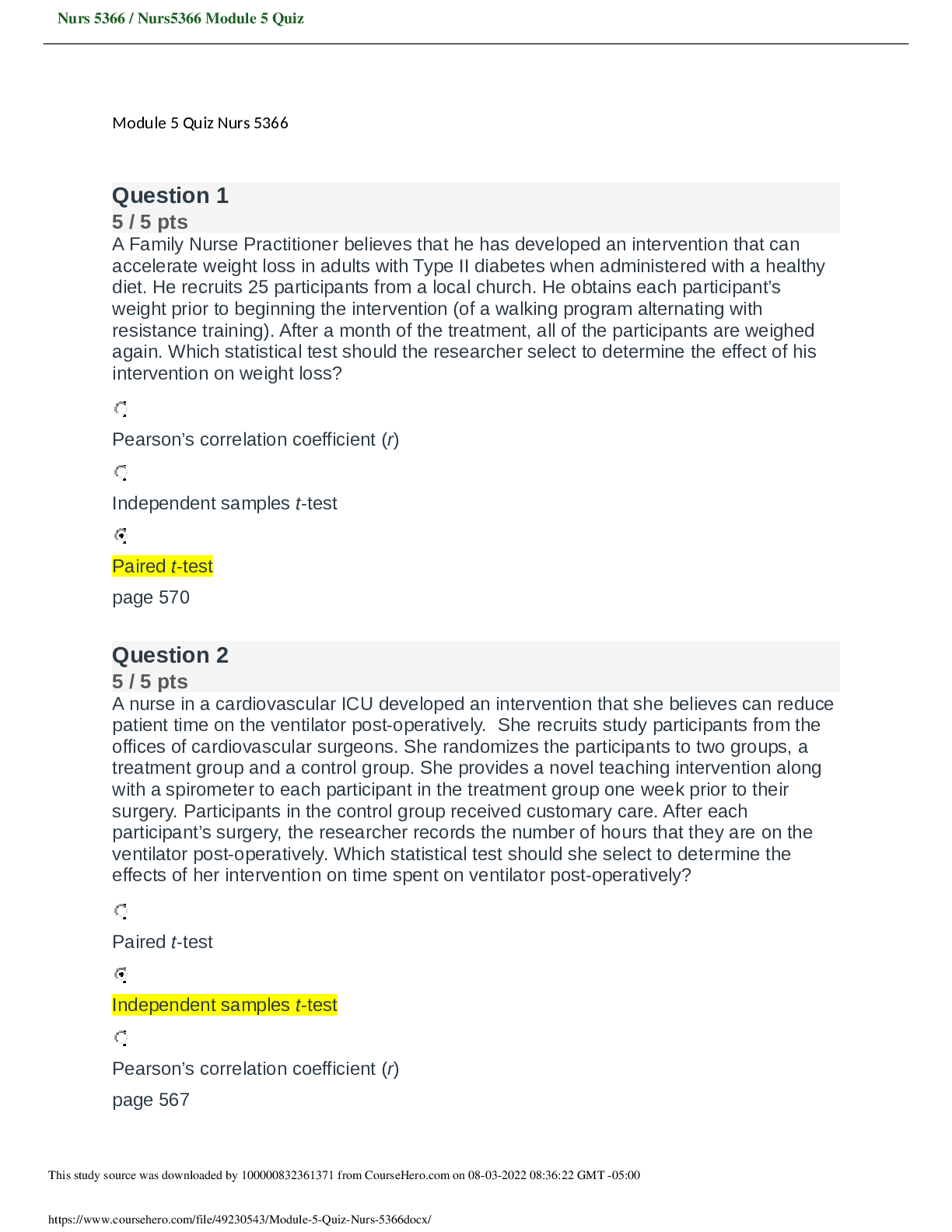
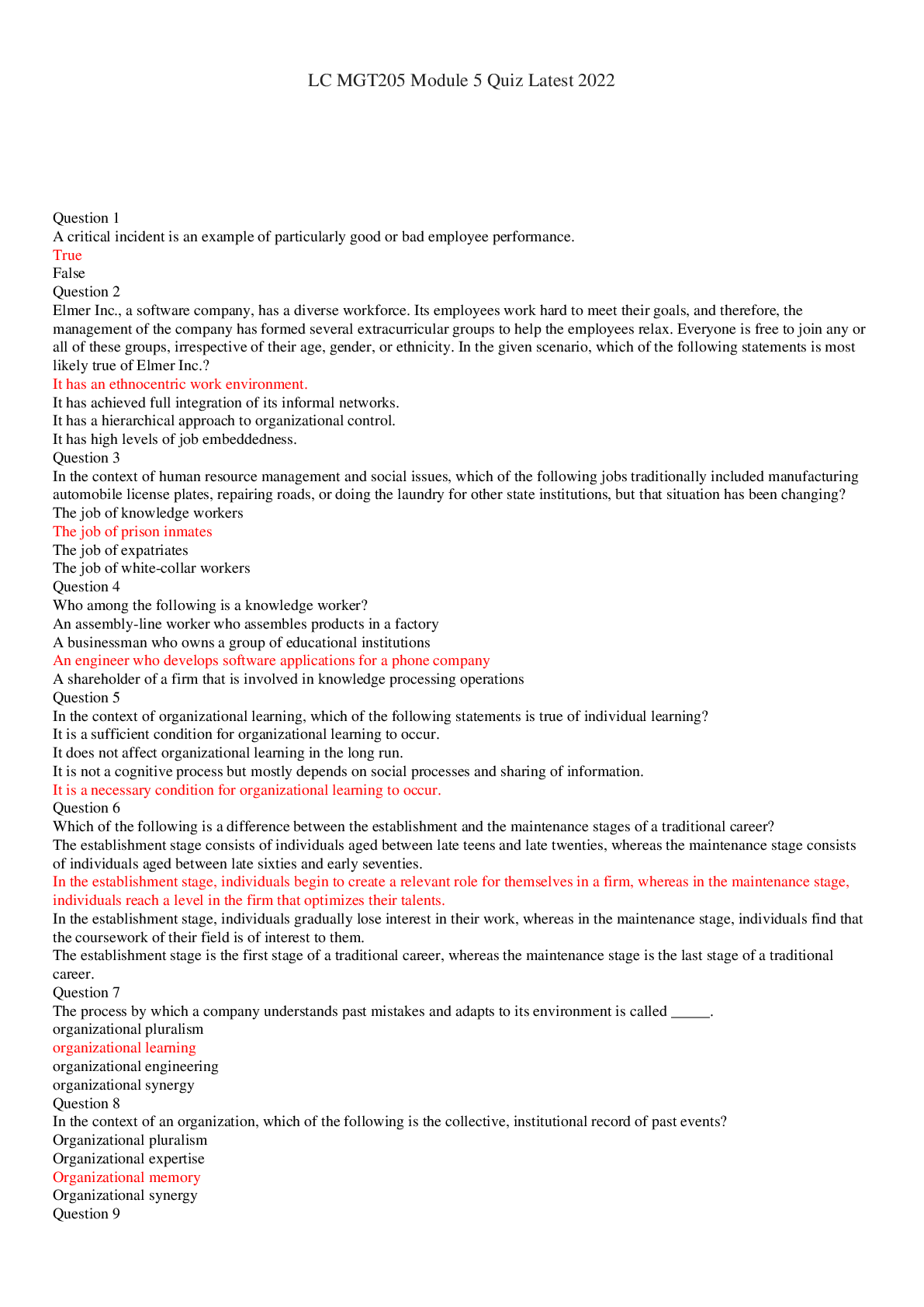


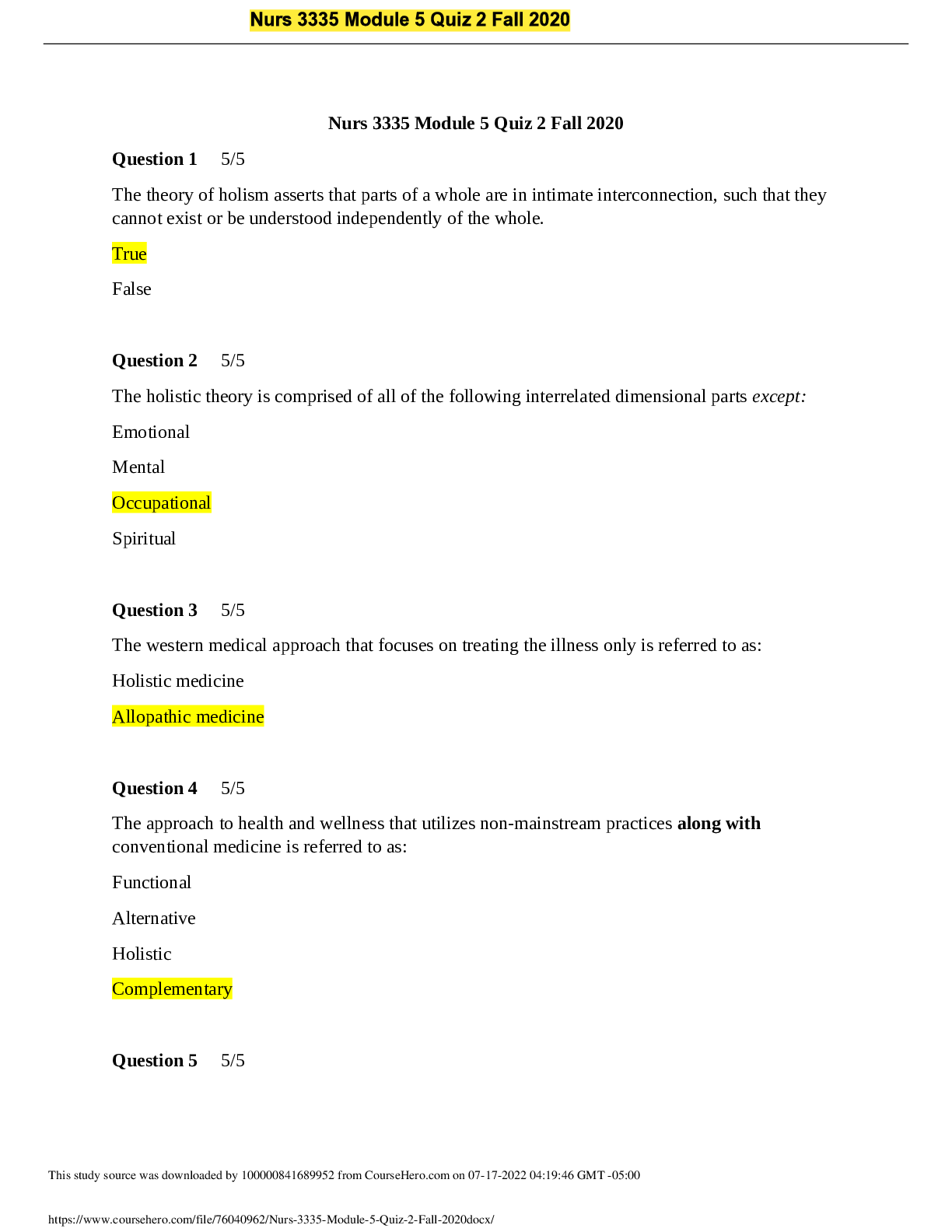
 100 Correct.png)
.png)
